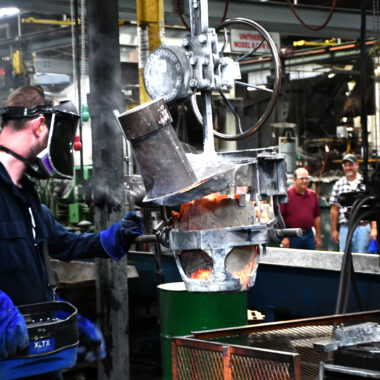Optimizing Effectiveness: Advanced Aluminum Casting Solutions Unveiled
Optimizing Effectiveness: Advanced Aluminum Casting Solutions Unveiled
Blog Article
Study the Globe of Aluminum Casting: Understanding the Various Approaches
Aluminum spreading is an essential procedure in the manufacturing industry, with numerous techniques employed to create specific and elaborate parts. From the conventional sand spreading method to the sophisticated die casting procedure, each method uses special benefits depending on the demands of the project.
Sand Spreading Method
Sand casting, a widely-used technique in light weight aluminum casting procedures, involves producing mold and mildews made of compressed sand for pouring liquified metal. This technique is affordable and very flexible, making it a preferred option for different markets. The procedure starts with the development of a pattern, normally constructed from timber or metal, which is after that pressed into the sand to leave an impact. The sand mix, commonly silica sand blended with a binder like clay, is tightly packed around the pattern to form a mold cavity. As soon as the mold and mildew prepares, it is securely put in a flask and molten light weight aluminum is put right into the cavity.
After the metal has actually cooled and strengthened, the sand mold is escaped to disclose the aluminum casting. Sand casting enables the manufacturing of complex shapes and huge components that might be pricey or tough to create utilizing other methods. It is additionally a lasting technique as the sand can be reused and made use of multiple times, reducing waste in the casting process.
Irreversible Mold And Mildew Technique

One substantial benefit of the Irreversible Mold Method is the enhanced dimensional precision it provides. The steel mold and mildew permits tighter resistances and better details in the final light weight aluminum spreadings compared to sand spreading techniques. This accuracy makes it a recommended choice for applications where limited dimensional control is critical, such as in the aerospace and vehicle markets.

Die Casting Process

Investment Casting Approach
Making use of have a peek at these guys an accuracy spreading method, Financial investment Casting Strategy includes developing elaborate light weight aluminum components by putting molten metal into a ceramic mold and mildew. This procedure, also known as lost-wax spreading, starts with the development of a wax pattern of the desired component (aluminum casting).
Financial investment spreading is generally made use of for producing elements in industries where complex layouts and limited resistances are needed, such as aerospace, auto, and clinical equipment. The adaptability and accuracy of the Investment Casting Method make it a valuable technique in the world of aluminum spreading.
Lost Foam Spreading Approach
Having explored the complex accuracy of Investment Casting Technique, the focus now changes to the innovative technique of Lost Foam Spreading in light weight aluminum element manufacturing. Lost Foam Spreading, also recognized as evaporative pattern spreading, is a modern-day method where a foam pattern of the wanted component is developed and after that covered with a refractory material. The covered foam pattern is then buried in sand, and molten light weight aluminum is poured into the mold and mildew. As the metal fills up the mold and mildew, the foam evaporates as a result of the warm, leaving a tidy tooth cavity in the shape of the preferred component.
In Addition, Lost Foam Casting is an economical process as it minimizes the requirement for cores and allows for the manufacturing of light-weight parts. Regardless of its advantages, Lost Foam Casting needs mindful control of the spreading process to ensure and prevent issues top quality components.
Final Thought
Finally, aluminum spreading provides a range of methods such as sand spreading, permanent mold method, die spreading, investment spreading, and shed foam spreading. Each approach has its own advantages and applications, making aluminum casting a versatile and commonly made use of procedure in numerous sectors. Comprehending the differences in between these techniques is important in selecting one of the most appropriate spreading method for particular manufacturing needs.
Sand spreading, a widely-used approach in light weight aluminum spreading procedures, involves creating mold and mildews made of compacted sand for pouring molten steel. aluminum casting.The Irreversible Mold Technique, like sand spreading, is an additional prevalent approach utilized in light weight aluminum spreading processes, supplying unique benefits in terms of mold and mildew reusability and dimensional precision. The steel mold permits for tighter tolerances and better information in the final aluminum castings contrasted to sand casting techniques. The two primary types of die spreading are cold chamber pass away spreading and hot chamber pass away casting, each suitable for different kinds of light weight aluminum alloys.In final thought, light weight aluminum spreading supplies more helpful hints a variety of techniques such as sand spreading, permanent mold and mildew strategy, die casting, investment casting, and lost foam casting
Report this page